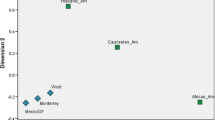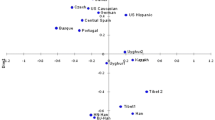Abstract
Allele frequencies and statistical parameters of forensic efficiency for 30 deletion–insertion polymorphisms (DIPs) were estimated in six Mexican populations. For this purpose, 421 unrelated individuals were analyzed with the Investigator DIPplex kit. The Hardy–Weinberg and linkage equilibrium was demonstrated for this 30-plex system in all six populations. We estimated the combined power of discrimination (PD ≥ 99.999999 %) and combined power of exclusion (PE ≥ 98.632705 %) for this genetic system. A low but significant genetic structure was demonstrated among these six populations by pairwise comparisons and AMOVA (F ST ≥ 0.7054; p ≤ 0.0007), which allows clustering populations in agreement with geographical criteria: Northwest, Center, and Southeast.
Similar content being viewed by others
References
Pereira R, Phillips C, Alves C, Amorim A, Carracedo A, Gusmão L (2009) A new multiplex for human identification using insertion/deletion polymorphisms. Electrophoresis 30:3682–3690
Fondevila M, Phillips C, Santos C, Pereira R, Gusmão L, Carracedo A, Butler JM, Lareu MV, Vallone PM (2012) Forensic performance of two insertion–deletion marker assays. Int J Legal Med 126:725–737
Rubi-Castellanos R, Martínez-Cortés G, Muñoz-Valle JF, González-Martín A, Cerda-Flores RM, Anaya-Palafox M, Rangel-Villalobos H (2009) Pre-Hispanic Mesoamerican demography approximates the present-day ancestry of Mestizos throughout the territory of Mexico. Am J Phys Anthropol 139(3):284–294
Martínez-Cortés G, Salazar-Flores J, Fernández-Rodríguez LG, Rubi-Castellanos R, Rodríguez-Loya C et al (2012) Admixture and population structure in Mexican-Mestizos based on paternal lineages. J Hum Genet 57(9):568–574
Martínez-Cortés G, Salazar-Flores J, Haro-Guerrero J, Rubi-Castellanos R, Velarde-Félix JS et al (2013) Maternal admixture and population structure in Mexican-Mestizos based on mtDNA haplogroups. Am J Phys Anthropol 151(4):526–537
Martínez-Cortés G, Nuño-Arana I, Rubi-Castellanos R, Vilchis-Dorantes G, Luna-Vázquez A et al (2010) Origin and genetic differentiation of three Native Mexican groups (Purepechas, Triquis and Mayas): contribution of CODIS-STRs to the history of human populations of Mesoamerica. Ann Hum Biol 37(6):801–819
Excoffier L, Laval G, Schneider S (2005) Arlequin ver. 3.0: an integrated software package for population genetics data analysis. Evol Bioinformatics Online 1:47–50
Dupanloup I, Schneider S, Excoffier L (2002) A simulated annealing approach to define the genetic structure of populations. Mol Ecol 11:2571–2581
Moreno-Estrada A, Gignoux CR, Fernández-López JC, Zakharia F, Sikora M et al (2014) Human genetics. The genetics of Mexico recapitulates Native American substructure and affects biomedical traits. Science 344(6189):1280–1285
Poetsch M, Bajanowski T, Pfeiffer H (2012) The publication of population genetic data in the International Journal of Legal Medicine: guidelines. Int J Legal Med 126(4):489–490
Acknowledgments
We thank the financial support from Qiagen and CONACYT (grant no. 129693) to H-RV.
Conflict of interest
The authors declare that they have no conflicts of interest.
Author information
Authors and Affiliations
Corresponding author
Electronic supplementary material
Below is the link to the electronic supplementary material.
Figure S1
Multidimensional scaling (MDS) plot based on FST distances between five Mestizo populations and one Amerindian group (Purepechas) from Mexico. Population clusters obtained by pairwise comparisons and AMOVA tests are indicated in ovals. (GIF 57 kb)
Table S1
(DOC 77 kb)
Table S2
(DOC 78 kb)
Table S3
(DOC 77 kb)
Table S4
(DOC 78 kb)
Table S5
(DOC 78 kb)
Table S6
(DOC 78 kb)
Table S7
(DOC 36 kb)
Table S8
(DOC 41 kb)
Table S9
(DOC 35 kb)
Rights and permissions
About this article
Cite this article
Martínez-Cortés, G., García-Aceves, M., Favela-Mendoza, A.F. et al. Forensic parameters of the Investigator DIPplex kit (Qiagen) in six Mexican populations. Int J Legal Med 130, 683–685 (2016). https://doi.org/10.1007/s00414-015-1242-y
Received:
Accepted:
Published:
Issue Date:
DOI: https://doi.org/10.1007/s00414-015-1242-y




